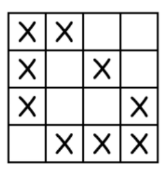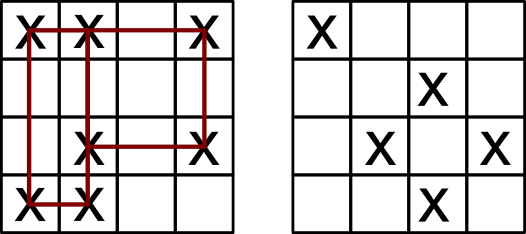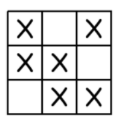Avoiding Rectangles
Hints:
1.Try solving a simpler version first!
A 3×3 grid solution might look like this:
X X _
X _ X
_ X X
Now think about how this pattern could extend to a 4×4 grid.
2. Start by filling the left column and the bottom row,
but leave the bottom-left corner empty.
What would be a clever way to complete the rest of the grid?
Look for a pattern that makes every row and column meet the puzzle’s rules!
Solution:
Solving this puzzle for any size grid is actually part of a much deeper, unsolved problem in mathematics! But don’t let that stop you—exploring this puzzle is a great way to learn and discover new patterns.
Let’s say the grid has m rows and n columns.
What We Know So Far:
-
1 or 2 rows: The best you can do is place m + n − 1 X’s.
-
3 rows: You can place m + n X’s. The 3×3 grid is a great starting point, and for more columns, you can just add one X in each new column.
The 3-row strategy looks different from the 1–2 row cases. So what happens when we try 4 or more rows?
A New Strategy:
Try this for an m × m grid:
-
Fill the leftmost column, skipping just the bottom square.
-
Then, for each of the other columns, place two X’s: one in the bottom row and one somewhere else.
This gives you a total of
(m − 1) + 2 × (m − 1) = 3 × (m − 1) X’s.
If the grid has more columns than rows (m < n), we can extend the pattern by adding one X per extra column. This gives a general formula:
n + 2m − 3 X’s.

This formula matches every successful example we’ve found so far—for any size grid with more than 1 row!



